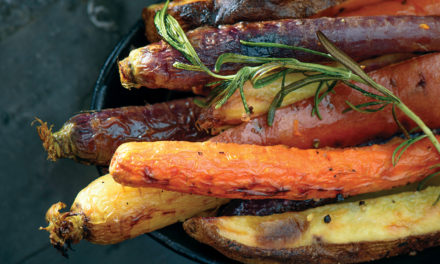These days, making the decision to eat locally sourced, organic, or foods free of hormones and artificial dyes isn’t enough. You have to know how to find them, as food manufacturers and marketers have gotten savvy about how they label their packaging, sometimes fooling you into buying something that’s not what you think.
As Americans become more cognizant of what they eat and curious about how food gets to their dinner tables, consumer demand for healthy, sustainable products also increases. In 2013, U.S. organic retail sales rose 11.5 percent to $35.1 billion, according to the Organic Trade Association. But with the assortment of labels slapped on foods these days claiming to be local, natural, and non-GMO, making the right decision in the grocery store isn’t easy. “The mental game of trying to navigate these different terms can be overwhelming,” says Robin McConaughy, owner of Double Brook Farm and Brick Farm Market in Hopewell, N.J. Instead of roaming the aisles for hours, carefully reading labels until your eyes glaze over, here’s a guide to help sort out the meaning of common terms.
Certified organic
What it means: Organic foods are produced without antibiotics, hormones, pesticides, irradiation, or bioengineering. Organic farmers must adhere to certain soil and water conservation methods and to rules about the humane treatment of animals.
What it says: The organic seal doesn’t necessarily mean the product is certified humane, grass-fed, or free-range, McConaughy warns. While the USDA requirements change constantly, consumers can rest assured they’re buying foods free of GMOs (genetically modified organisms). “If you have a corn or soy allergy or need to stay away from GMOs, certified organic is your best bet,” McConaughy says.
Free-range
What it means: The flock must be provided shelter in a building, room, or area with continuous access to the outdoors.
What it says: In some cases, free-range can mean access only through a “pop hole” with no full-body access to the outdoors and no minimum space requirement, according to Humane Farm Animal Care. “You can have an entire warehouse of chickens the size of a football field with one small opening the size of a doggie door, and that’s considered free-range, because they have access to the outside,” McConaughy says. “Not all free-range operations are like that—some are better, some are worse.”
Cage-free
What it means: Hens can freely roam a building, room, or enclosed area.
What it says: The majority of U.S. egg-laying hens are confined in cramped, wire-floored cages. But cage-free doesn’t mean the hens are treated humanely. “If you want to know for sure it’s raised in a humane way, you need to know your farmer and see the animals on the land,” McConaughy says. To play it safe, she suggests buying eggs directly from local farms that have pastured chickens. “Get local and fresh if you can because it tastes the best and they last forever.”
Pasture-raised
What it means: The USDA has not developed a federal definition for pasture-raised products. According to McConaughy, whose farm sells pasture-raised beef, pork, chicken, turkey, and lamb, it means the animals have access to shelter but spend most of their time outdoors, living off the land. “Everyone has a different interpretation,” she stresses.
What it says: “Pasture-raised is the gold standard,” McConaughy says. However, the animal’s diet may be supplemented with grains that contain GMOs. “Chickens, turkeys, and pigs need to have a supplement to their diet,” she says. “So that’s important to a lot of people who have allergies, because there could be soy, corn, and/or GMO grains in the supplement.”
Non-GMO
What it means: GMOs are plants or animals whose cells have been modified by exposure to genes from another species in order to introduce new traits or characteristics. High-risk crops include canola, corn, and soy. The Non-GMO Project Verified Seal indicates the product has been produced according to best practices for GMO avoidance.
What it says: There are so many levels of GMO products out there, McConaughy says, it can be hard to avoid altogether. Some consumers may feel comfortable eating meat from a pasture-raised chicken who has supplemented its diet with GMO feed since it’s one level removed. In other words, they’re not directly ingesting a GMO plant, they’re ingesting the animal that ate the plant. “Our food world has gotten so complicated. You have to make those decisions on a case-by-case basis,” she says.
Grass-fed
What it means: Grass-fed animals receive a majority of their nutrients from grass through their life.
What it says: The grass-fed label does not limit the use of antibiotics, hormones, or pesticides. It also doesn’t mean the animal was pasture-raised. “The animal can be in a warehouse with no access to sunlight and fresh air but be given hay as its steady diet,” she says. “You want a rotationally grazed, pasture-based animal.”
Typically, 100 percent grass-fed means GMO-free. Brick Farm Market sells mainly 100 percent grass-fed, pasture-rasied beef, which it sources from a partner farm, Thistle Creek Farms in Tyrone, Pa., and a small amount of grain-finished beef from a local distributor. McConaughy’s Double Brook Farm raises 100 percent grass-fed and pasture-raised lamb, as well as pastured meat birds, laying hens, turkeys, and pigs, which are given a supplemental feed purchased from a local grower. “It’s a balance: We chose to go local for now and are simultaneously dedicating a lot of land to start raising GMO-free grains for the animals moving forward. We’re getting there, but it takes time.”








